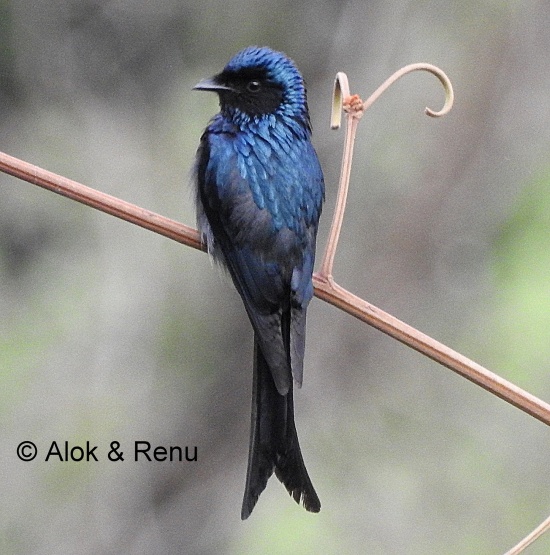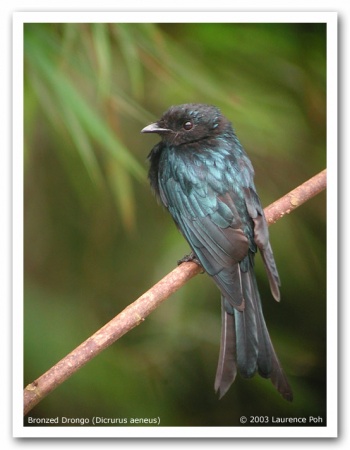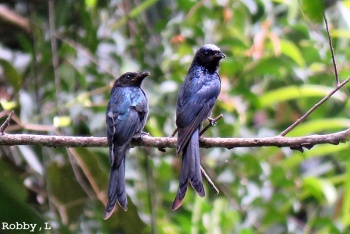
Photo © by Alok Tewari
Sat Tal Forest, Alt.5500 ft., Uttarakhand Himalayas, India, 4 April 2019
- Dicrurus aeneus
Identification
Size: 22-24 cm (8½-9½ in)
Small size with black plumage, heavily glossed with blue especially on the breast. Heavily spangled on head, neck and breast.
Sexes similar, females are slightly smaller. Juveniles are initially sooty-brown.
Similar Species
Slimmer then other drongos.
Difference from Lesser Racket-tailed Drongo with abraded tail feathers shafts by deeply forked tail.
Distribution
Found on the Indian Subcontinent east to Bangladesh, Burma, southern China (Tibet, Yunnan, Guangxi, Hainan) south to Indochina, Malaysia, Sumatra and Borneo. Also on Taiwan.
Common and widespread in most of its range.
Taxonomy
Subspecies
There are 3 subspecies[1]:
- D. a. aeneus:
- D. a. malayensis:
- Southern Malay Peninsula, Sumatra and Borneo
- D. a. braunianus:
Habitat
Sub-montane rain forest and forest edges and broad-leaved woodland.
Behaviour
Often seen flying in large group across the canopy.
Frequents the canopy of forests, at those area where there are gaps. At the forest edges, perches on small trees and bamboo groves from which it hawks for prey, mid-storey level.
Diet
Feeds mainly on insects, reported to feed on flower nectar.
Breeding
Breeding season mainly April to May. The nest is a shallow irregular cup made of plant material. It's suspended like a hammock 2 - 6m above the ground in a tree.Lays generally 3 eggs.
Vocalisation
Loud liquid bell-like notes, once heard never forgoten. Also has harsh calls, typical of the family.
Recording © by Alok Tewari
Sat Tal Forest, Alt. 5500 ft., Dist. Nainital, Uttarakhand Himalayas, India, 11 October 2018.

Photo © by Alok Tewari
Sat Tal Forest, Alt.5500 ft., Uttarakhand Himalayas, India, March-2018
References
- Clements, J. F., T. S. Schulenberg, M. J. Iliff, D. Roberson, T. A. Fredericks, B. L. Sullivan, and C. L. Wood. 2017. The eBird/Clements checklist of birds of the world: v2017, with updates to August 2017. Downloaded from http://www.birds.cornell.edu/clementschecklist/download/
- Del Hoyo, J, A Elliott, and D Christie, eds. 2009. Handbook of the Birds of the World. Volume 14: Bush-shrikes to Old World Sparrows. Barcelona: Lynx Edicions. ISBN 978-8496553507
- Rasmussen, PC and JC Anderton. 2005. Birds of South Asia: The Ripley Guide. Barcelona: Lynx Edicions. ISBN 978-8487334672
- BF Member observations
Recommended Citation
- BirdForum Opus contributors. (2024) Bronzed Drongo. In: BirdForum, the forum for wild birds and birding. Retrieved 9 November 2024 from https://www.birdforum.net/opus/Bronzed_Drongo
External Links
GSearch checked for 2020 platform.





